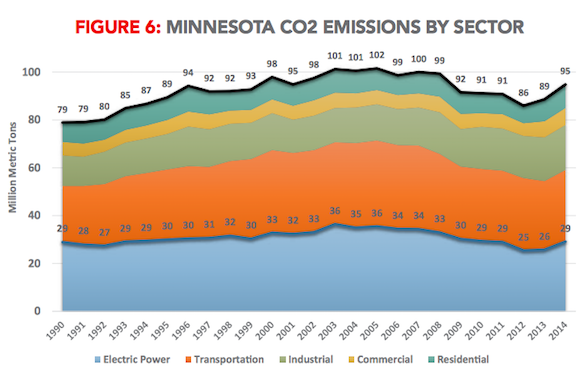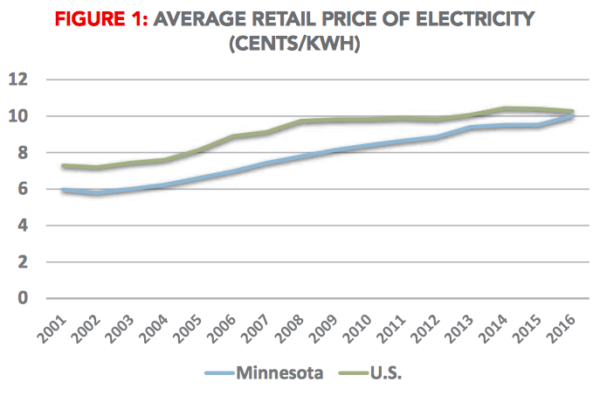Liberals will tell you that Minnesota is one of the nation’s leaders in “green” energy, so its experience represents a good test: can green energy fulfill the extravagant promises made by its backers?
The answer is a resounding No, according to a blockbuster paper by our own Steve Hayward and Center of the American Experiment’s Peter Nelson. The paper, titled “Energy Policy in Minnesota: the High Cost of Failure,” can be read or downloaded at the Center’s web site.
Minnesota is a poor place for solar power, so its renewable policies have focused on wind. Minnesota has gone whole hog for wind energy, to the tune of–the Hayward/Nelson paper reveals, for the first time–approximately $15 billion. It is noteworthy that demand for electricity in Minnesota has been flat for quite a few years, so that $15 billion wasn’t spent to meet demand. Rather, it replaced electricity that already was being produced by coal, nuclear and natural gas plants.
Wind energy is intermittent and unreliable; it can only be produced when the wind is blowing within certain parameters, and cannot be stored at scale. It is expensive and inefficient, and therefore patently inferior to nuclear, coal and natural gas-powered electricity, except in one respect–its “greenness.” That greenness consists of not emitting carbon dioxide. So, for $15 billion, Minnesota must have bought a dramatic reduction in the state’s CO2 emissions, right?
Wrong. As the Hayward/Nelson paper shows, that massive investment hasn’t even made a dent. This chart shows total CO2 emissions from the state, by sector, from 1990 through 2014. There was a slight dip in 2012 and 2013 not because of wind power, but because an accident put one of the state’s major coal-fired units out of commission for two years:
Minnesota’s massive investment in wind power has reduced CO2 emissions from the electricity generation sector slightly, but that reduction has been below average compared with the nation as a whole. Why? Because the most effective way to reduce CO2 emissions, if you think that is a worthy goal, has been to replace coal with natural gas. Wind power has many defects, one of which is that it is windiest in the spring and fall, when demand for electricity is at its low ebb, and least windy in the summer and winter, when electricity demand peaks. So what fills those gaps? In Minnesota, coal does.
So Minnesota’s colossal investment in wind energy has been a total failure, in its own terms–a failure for which the state’s consumers and businesses have paid dearly. Historically, Minnesota enjoyed the advantage of relatively cheap electricity. Generally, electricity prices were around 18% lower in Minnesota than the national average. This was a big deal in a state where some other costs–e.g., the price of heating your home in the winter–were inevitably higher than average.
So what has happened to that 18% price discount during the years when billions have been spent on windmills and transmission lines? It has disappeared. In fact, 2017 is the first year on record in which the price of electricity in Minnesota is above the national average. Way to go, greenies.
The sad story of Minnesota’s green energy failure is one that no doubt is being replicated around the country. And one of the ironies of green energy is that it is terrible for the environment. Both wind and solar energy require enormous amounts of land compared with conventional, reliable energy sources. Minnesota has scarred its landscape with endless acres of giant windmills and, to a lesser degree, solar panels. When those windmills begin to rust and fall still, the environmental damage will be even greater. And the green cronies who are now making millions through their political connections will be long gone.
There is much more in the paper, which you can read or download at the link above.


Notice: All comments are subject to moderation. Our comments are intended to be a forum for civil discourse bearing on the subject under discussion. Commenters who stray beyond the bounds of civility or employ what we deem gratuitous vulgarity in a comment — including, but not limited to, “s***,” “f***,” “a*******,” or one of their many variants — will be banned without further notice in the sole discretion of the site moderator.